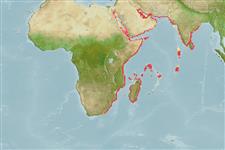Teleostei (teleosts) >
Eupercaria/misc (Various families in series Eupercaria) >
Sparidae (Porgies)
Etymology: Crenidens: Latin, crenulatus = cut, clipped + Latin, dens, dentis = teeth (Ref. 45335).
More on author: Forsskål.
Environment: milieu / climate zone / depth range / distribution range
Ecology
Marine; demersal. Subtropical; 30°N - 34°S, 25°E - 86°E
Western Indian Ocean: Red Sea, East Africa along the east coast of Africa to Aliwal Shoal in South Africa; with juveniles reported to have also been found in Algoa Bay, South Africa.
Size / Weight / Age
Maturity: Lm ? range ? - ? cm
Max length : 30.0 cm TL male/unsexed; (Ref. 3198); common length : 28.0 cm TL male/unsexed; (Ref. 5450)
Caught in shallow coastal waters, mainly in muddy quiet areas. In the northern part of the Indian Ocean, it is caught all year round and consumed fresh. In the southern part of the Indian Ocean, it is fished mainly for bait. Feeds mainly on algae, also invertebrates such as crustaceans and worms.
Life cycle and mating behavior
Maturity | Reproduction | Spawning | Eggs | Fecundity | Larvae
Smith, J.L.B. and M.M. Smith, 1986. Sparidae. p. 580-594. In M.M. Smith and P.C. Heemstra (eds.) Smiths' sea fishes. Springer-Verlag, Berlin. (Ref. 3198)
IUCN Red List Status (Ref. 130435)
Threat to humans
Harmless
Human uses
Fisheries: commercial; bait: usually
More information
Common namesSynonymsMetabolismPredatorsEcotoxicologyReproductionMaturitySpawningSpawning aggregationFecundityEggsEgg development
ReferencesAquacultureAquaculture profileStrainsGeneticsElectrophoresesHeritabilityDiseasesProcessingNutrientsMass conversion
Tools
Can't connect to MySQL database fbquizv2. Errorcode: Too many connections
